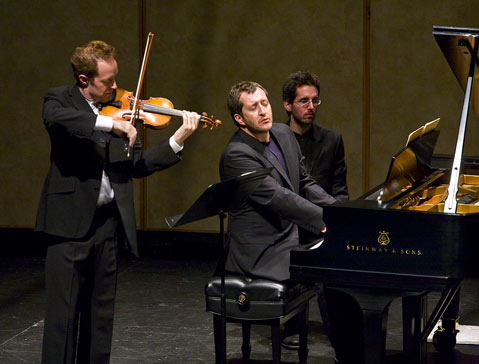Thomas Ads and Anthony Marwood at the Lobero Theatre
Two of England's Brightest Musicians Bring Stravinsky Back to S.B.

England’s most distinguished young composer, Thomas Ads, and its top violinist, Anthony Marwood, came to the Lobero stage on Friday to perform the music of Igor Stravinsky. In an extraordinary coincidence, these musicians have been traveling the world performing arrangements made by Stravinsky for himself and the violinist Samuel Dushkin that were played at the Lobero by the original duo more than 70 years ago, on March 16, 1937, in a program that was also sponsored by CAMA. This fantastic opportunity to imagine what impression Stravinsky might have made on a Santa Barbara audience in the late 1930s was more than fulfilled by a performance that was both technically superb and aesthetically inspiring.
Stravinsky created these transcriptions, and the approximately 15-minute Duo Concertant, the only piece written specifically for the instrumentation, in order to make the case for his personal form of musical modernism. The result is a kind of recital that would be unlikely to occur otherwise-something longer and more substantial than one would ordinarily expect, and with a specific and powerful aesthetic argument at its core.
The opening work, which came from the Pulcinella suite, derives from Stravinsky’s characteristically quirky and complex take on the music of the 18th century. Like his near-contemporary Richard Strauss, Stravinsky composed in a neo-classical idiom not in order to reassure listeners, but rather to make the familiar seem strange. The seeds of his radical distortions of time and experiments in rhythm were strongly in evidence here, as were hints of his trademark dissonant close harmonies. Ads has a distinctive touch at the keyboard that allows him to render Stravinsky’s “inside-out” logic without offending the ear.
The second and third works performed, a short Pastorale and a longer song from “The Nightingale,” gave Anthony Marwood multiple opportunities to demonstrate his tone control, lyricism, and panache. The finale of the first half was the Duo Concertant, a masterwork that manages to compress nearly all of Stravinsky’s many contributions to the composer’s repertoire of effects into a single piece.
After the interval, another substantial statement was made, this time involving the appropriation and transformation of folk melodies. As the Russian influence came to the fore, Marwood’s playing took on the vocal qualities of gypsy music. Overall, this was one of the major musical events of the year, a feast of beautiful sounds, some strange, some familiar, all driven by an encompassing intellect, once present in person at the Lobero, and still present in spirit and in mind.



